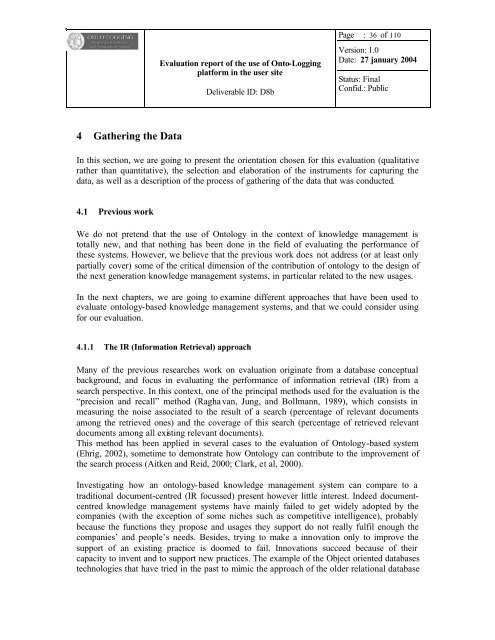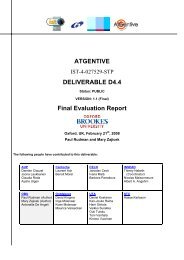pdf 820Kb - INSEAD CALT
pdf 820Kb - INSEAD CALT
pdf 820Kb - INSEAD CALT
Create successful ePaper yourself
Turn your PDF publications into a flip-book with our unique Google optimized e-Paper software.
4 Gathering the Data<br />
Evaluation report of the use of Onto-Logging<br />
platform in the user site<br />
Deliverable ID: D8b<br />
Page : 36 of 110<br />
Version: 1.0<br />
Date: 27 january 2004<br />
Status: Final<br />
Confid.: Public<br />
In this section, we are going to present the orientation chosen for this evaluation (qualitative<br />
rather than quantitative), the selection and elaboration of the instruments for capturing the<br />
data, as well as a description of the process of gathering of the data that was conducted.<br />
4.1 Previous work<br />
We do not pretend that the use of Ontology in the context of knowledge management is<br />
totally new, and that nothing has been done in the field of evaluating the performance of<br />
these systems. However, we believe that the previous work does not address (or at least only<br />
partially cover) some of the critical dimension of the contribution of ontology to the design of<br />
the next generation knowledge management systems, in particular related to the new usages.<br />
In the next chapters, we are going to examine different approaches that have been used to<br />
evaluate ontology-based knowledge management systems, and that we could consider using<br />
for our evaluation.<br />
4.1.1 The IR (Information Retrieval) approach<br />
Many of the previous researches work on evaluation originate from a database conceptual<br />
background, and focus in evaluating the performance of information retrieval (IR) from a<br />
search perspective. In this context, one of the principal methods used for the evaluation is the<br />
“precision and recall” method (Ragha van, Jung, and Bollmann, 1989), which consists in<br />
measuring the noise associated to the result of a search (percentage of relevant documents<br />
among the retrieved ones) and the coverage of this search (percentage of retrieved relevant<br />
documents among all existing relevant documents).<br />
This method has been applied in several cases to the evaluation of Ontology-based system<br />
(Ehrig, 2002), sometime to demonstrate how Ontology can contribute to the improvement of<br />
the search process (Aitken and Reid, 2000; Clark, et al, 2000).<br />
Investigating how an ontology-based knowledge management system can compare to a<br />
traditional document-centred (IR focussed) present however little interest. Indeed documentcentred<br />
knowledge management systems have mainly failed to get widely adopted by the<br />
companies (with the exception of some niches such as competitive intelligence), probably<br />
because the functions they propose and usages they support do not really fulfil enough the<br />
companies’ and people’s needs. Besides, trying to make a innovation only to improve the<br />
support of an existing practice is doomed to fail. Innovations succeed because of their<br />
capacity to invent and to support new practices. The example of the Object oriented databases<br />
technologies that have tried in the past to mimic the approach of the older relational database
















